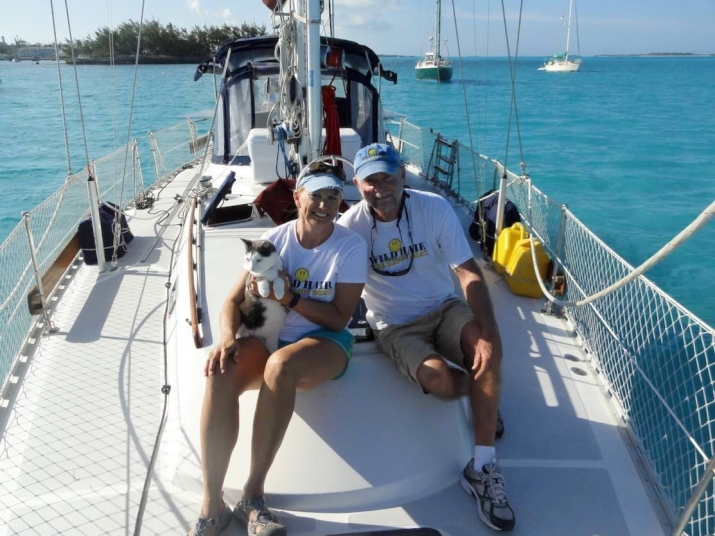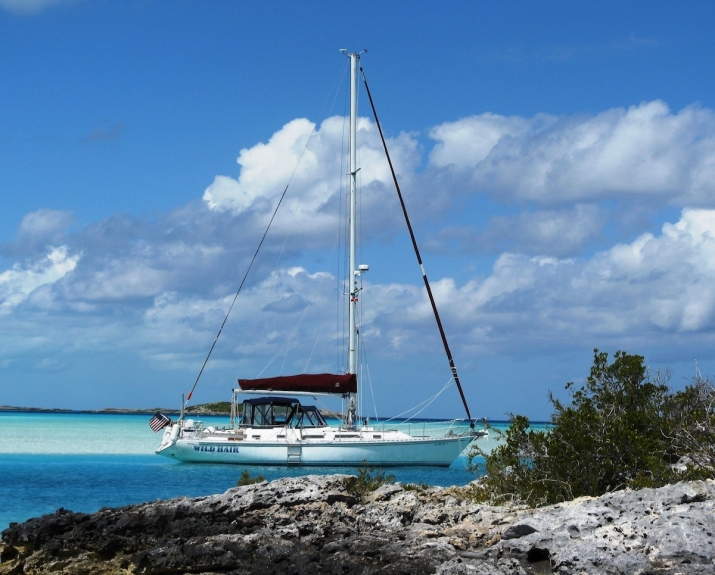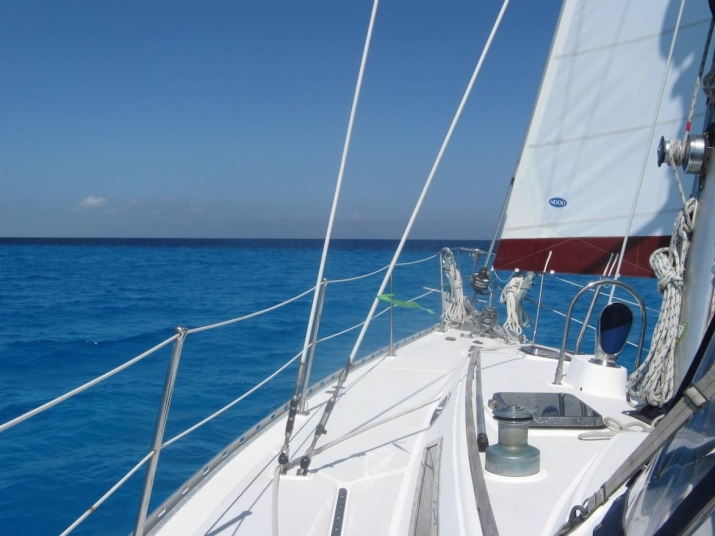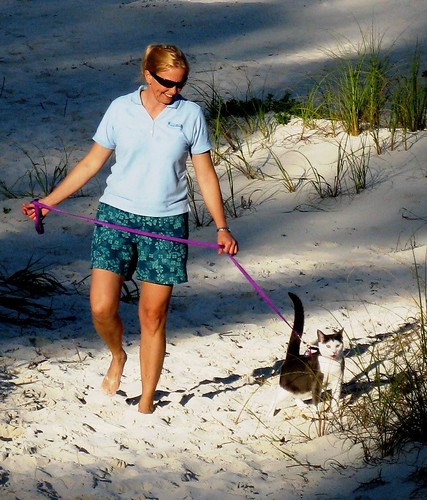FEATURES|THEMES|Environment and Wildlife
Fearlessness and Climate Change: A Better Way to Be in a Suffering World
 The fearless crew of Wild Hair— Heather with husband Dave and Dinghy-the-Sailor-Cat
The fearless crew of Wild Hair— Heather with husband Dave and Dinghy-the-Sailor-CatIn 2007, I took a multi-year sabbatical from my career as an environmental professional and set sail on a 15,000-nautical-mile ocean voyage in a small sloop with my husband and cat. As a practicing Buddhist ordained into the core community of Zen master Thich Nhat Hanh, I considered the journey a once-in-a-lifetime chance to study the nature of reality in the wilderness of the Atlantic Ocean—the Great Atlantic Teacher. Ocean of Insight: A Sailor’s Voyage from Despair to Hope (Parallax Press 2016) is a memoir of my physical and spiritual passage—the story of one woman’s death-defying and life-affirming journey on the open ocean.
Here is an excerpt from chapter one depicting the first time I was afraid for my life, and the first time—according to my boat broker—that I really went sailing because you haven’t been sailing until you’ve been really afraid! It is the story of a storm off Tilloo Cay in the Bahamas, in which I was reduced to an animal in the jaws of fear. Terrified, I left the searchlight off and in my lap—preferring willful ignorance to the frightening reality around me. In these paragraphs, I reflect on the experience and make a connection to the climate crisis for a profound lesson on fearlessness.
~
My life as a change agent began when our son and daughter were babies. In 1996, I launched the nonprofit conservation organization I eventually spent nearly a decade and a half leading. I loved the work and arrived to the office each day with enthusiasm and a sense of purpose. My coworkers and I helped inner-city communities redesign schoolyards, slow and reroute traffic to increase neighborhood walkability and bikeability, create farmers’ markets and skateboard parks, and put important landmarks on the national register of historic places. We partnered with local residents and bought toxic land, mitigated contamination, and reengineered nature’s ecological services back into the landscape (slowing and absorbing storm water, recharging drinking water aquifers). As a result, vibrant parks and community gardens, clean air, pools of clear water, and neighborhood friendships flourished where blight and relative isolation once stood.
Over time, I noticed the growing concern around climate disruption triggered emotions in me that I didn’t allow myself to fully feel. What started in the 1990s as a small pang of guilt over a life of American privilege became a panicky kind of irritability for someone to do something—anything to avoid or at least soften the global catastrophic loss. Subconsciously, I blamed myself for being too dense to know exactly how to take action. Then I’d remember I was already tied up managing a conservation organization and conclude it was OK that I didn’t have energy to overhaul my and my family’s daily routines. Still, every once in a while, I’d have to shrug off the guilt I felt driving my car from Madison to Milwaukee for a meeting instead of taking the bus. This is how my back-and-forth emotional responses to climate change sizzled just below consciousness; it was an internal tug of war that was at once quiet and fairly hellish now that I think about it.
When I decided to hand the organization’s reins over to a new director, I promised myself I’d bring one question with me as I met the Great Atlantic Teacher: how am I to live in a suffering world?
The boat broker’s observation that I hadn’t really been sailing until I’d been really afraid applies, I think, to climate disruption. Sitting with this in meditation, turning the idea over like a rock, I discovered underneath it a partial answer to my central question. I had never really let the reality of climate change land in my body. I’d not honored my fear as valuable information. Sure, I knew about climate change because I had a master’s degree in environmental science, but I kept the pain of it at a professional, analytical distance, protected myself from the full emotional impact of what’s coming down the pipe. For years I adhered to a form of voluntary ignorance. The storm off Tilloo Cay taught me that ignorance is worse than fear, because not-knowing actually compounds danger.
Not anymore. This is my life, my planet, and caring for it is my responsibility. If I love my life (which I do), then I am going to get hold of this fear, experience it fully, and not let it jam my circuitry.
I suspect many of us in the climate movement have either dipped into the data in an analytical or emotionally distanced way, or jumped in headlong and started reacting like inexperienced horse trainers banging pots and pans to frighten the herd into cooperation. By making ever-increasing amounts of noise and focusing on apocalyptic projections, we have sent a lot of folks running to the hills in denial. Of those who remain, some are in the heated lather of panic and others are nearly catatonic, completely overwhelmed. A precious few are operating somewhere in between: calmly, clear-headed, and with skill in the midst of strong emotions resonating in their bodies.
I wonder what would happen if each of us coexisted with the uncomfortable fear, anger, heartbreak, and guilt reverberating in our bones and chose to behave in ways that are composed, plain-spoken, and compassionate. What if the climate-concerned were like horse whisperers who modeled the fearlessness and wise action they wished others would adopt?
 Wild Hair floating in the company of the Great Atlantic Teacher
Wild Hair floating in the company of the Great Atlantic TeacherThe wild sea on New Year’s Eve showed me that fear is a fire capable of burning away complacency, but like all flames it can overwhelm and destroy. Observing and monitoring the strong emotion of the moment, putting it in check, helps me remain calm, understand the danger I am in, and grow more skillful in my response.
I offer the meditation below as a tool to help myself and others dwell peacefully in the presence of strong emotions. Practice it when sitting comfortably with your body and mind quiet. Take your time. Breathe slowly in a natural and relaxed way as you focus your awareness on the text. If (when) your mind wanders, bring it gently back to the sensation of your breathing and the words of the guided meditation. You may enjoy having a light smile on your lips.
Breathing in, I am aware of the sensation of my in-breath.
Breathing out, I am aware of the sensation of my out-breath.
In, breath sensations.
Out, breath sensations.
(Ten breaths)
Breathing in, I am aware of sensations present throughout my body.
Breathing out, I relax into the sensations throughout my body.
In, body sensations.
Out, relax into body sensations.
(Ten breaths)
Breathing in, I am aware of feelings that are in my body.
Breathing out, I relax into the feelings that are in my body.
In, aware of feelings.
Out, relax into feelings.
(Ten breaths)
Breathing in, I am aware climate change threatens life on Earth.
Breathing out, I feel the sensations of climate change awareness land in my body.
In, aware of climate change.
Out, feel climate change reality in my body.
(Ten breaths)
Breathing in, I am aware climate change threatens life on Earth.
Breathing out, I feel climate change awareness stir my emotions.
In, aware of climate change.
Out, feel strong emotions.
(Ten breaths)
Breathing in, I relax into the sensations of climate change in my body.
Breathing out, I relax into the emotions climate change stirs.
In, relax into my body.
Out, relax into my emotions.
(Ten breaths)
 One of many spectacular days sailing the 15,000-nautical-mile journey
One of many spectacular days sailing the 15,000-nautical-mile journeyExcerpted from Ocean of Insight: A Sailor’s Voyage from Despair to Hope by Heather Lyn Mann © 2016. Reprinted with permission of Parallax Press.
Related features from Buddhistdoor Global
Wildlife on the Brink
Buddhist Perspectives on Sustainable Economic Development
Exploring Engaged Buddhism with Professor Christopher Queen
Palri Buddha Park - A Conservation Project in East Bhutan















